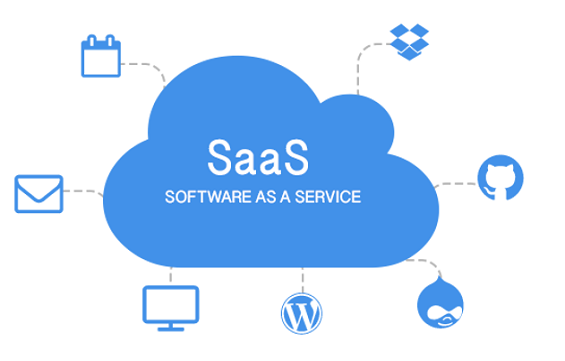The SaaS industry has completely changed the way organizations work today. The amazing strides in the SaaS cloud computing technology have enabled businesses to do away with storing disks, implementing various software installation processes, etc. The success of SaaS across various business sectors has been phenomenal, which has resulted in several companies grabbing the opportunity to develop their own SaaS projects.
However, businesses should keep in mind that cloud service development is quite different from your traditional software development lifecycle. Also, different SaaS project developers may encounter a different set of unique challenges while developing their cloud solutions. Hence, it is highly recommended to have a thorough understanding of the SaaS software development lifecycle, its key stages, etc., in order to successfully develop, build, and deploy a cloud solution.
Table of Contents
SaaS Software Development

The two focus areas of the SaaS Application Development Lifecycle approach are what are the capabilities of the platform and what is the operational scope. As you are aware, SaaS is a cloud-based software sharing solution through which the cloud solution provider can develop and maintain all their cloud applications. The solutions are available to the customers over the internet with a pay-as-you-go pricing model. The cloud provider also ensures that all the software updates are offered automatically, and all the hardware, middleware, security, and application software are managed as required.
Initially, when SaaS was developed, it was capable of providing solutions to only one specific issue at a time. However, the SaaS model has evolved tremendously, and today it is one of the most sought-after solutions by businesses of all types and sizes.
Key Stages of SaaS Software Development Lifecycle
Let’s take a look at the key stages involved in the SaaS development lifecycle.
Envisioning
The first phase is similar to any other software development phase. This is the first step wherein the project vision and scope are defined from the business viewpoint. There are several steps involved in this stage, such as creating and validating the application idea, conducting market research, identifying the business needs, creating short-term and long-term business plans, negotiating with potential investors and partners, assessing the various cloud architecture, etc. This phase requires the involvement of various stakeholders like developers, product managers, investors, cloud consultants, architects, marketers, etc.
Evaluating
The next step is the evaluation phase, which is also one of the most critical phases. The success of your solution architecture greatly depends upon the cloud platform’s capabilities and architecture. Another reason this is a critical phase is that once the SaaS project is operational, it is difficult to change its architecture or migrate to a different cloud platform. Some key items to consider while searching for the right platform include:
- Outline the requirements, technical architecture, and functionality clearly.
- Assess the security and data privacy
- Understand the platform’s performance capability, scalability, reliability, disaster recovery, etc.
- Outline your financial plan and monetization models for your SaaS product
- Find out about the management tools and support available.
Planning
This is the main stage of your SaaS software development lifecycle, wherein all the action takes place. The number of activities and deliverables will depend upon the size and complexity of your SaaS project. The planning phase includes planning your short-term as well as long-term project goals. Some of the steps included in the stage are:
- Finalizing the requirements and converting them into technical specifications for the developers
- Finalizing the project’s plans, functional specifications, team structure, etc.
- Designing the project schedule
- Outlining the marketing and communication strategies
- Developing a strategy for risk mitigation
Subscribing
In this stage, you need to set up your subscription plans with the cloud provider that you have chosen. There are several checkpoints that need to be completed by this phase, such as:
- Finalizing all the decisions related to architecture and pricing
- Go through the documentation provided by the cloud service provider and test their services.
- Assess and confirm the security and data privacy compliance
- Prepare a backup and disaster recovery plan.
- Develop your subscription management strategy
- Finally, sign the Service level agreement with your cloud service provider.
Developing
The developing phase starts by first setting up the initial feature set depending on the architecture you have selected. Once this is done, you can add new updates, functionalities, improvements, etc., as required. The key steps involved in this phase include:
- Setting up the development environment
- Conducting different types of testing, developing, and deployment
- Adding in the security policies and functionalities
- Fine-tuning the various processes like data synchronization, extraction, uploading, etc.
- Implementing and testing the various processes related to helping desk and support
Operations
The final stage in the SaaS development lifecycle is the operations phase. This is the phase where you finally deploy and maintain your SaaS application. Key steps involved in the operations phase are:
- Finalizing all the support and training plans
- Perform load testing and disaster recovery
- Develop the deployment plan
- Application integration in the cloud platform
- Monitor the performance and make changes if required
- Collect feedback to plan for future deployments
Conclusion
There is no doubt that SaaS is the future, and since every SaaS project is unique, it will have its share of challenges. However, these challenges can be overcome by ensuring that you follow the key stages of the SaaS software development lifecycle. This lifecycle is a continuous process, and by taking your experience and industry requirements into consideration, you will be able to successfully develop your SaaS solution.
If you wish to check out some of the top SaaS solutions across 300 different categories, do check out SaaSworthy!






